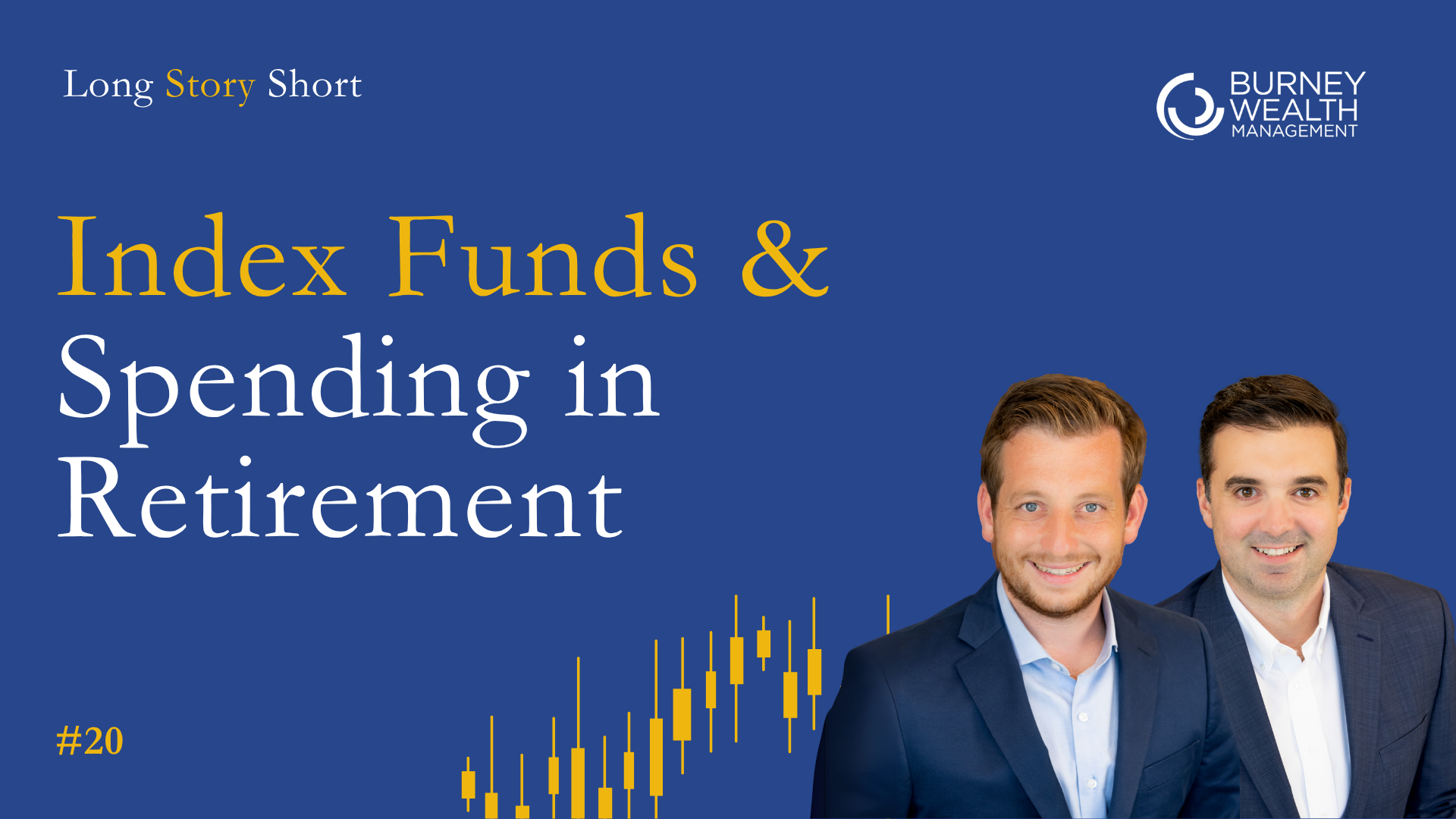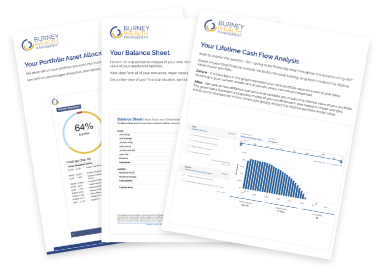Index Funds and Retirement Spending Strategies | Ep 20

Watch or listen to the episode below:
Andy showed up to the podcast recording dressed as an index fund. He covered himself with ticker symbols - massive squares for Nvidia, Microsoft, and Apple on his chest, smaller rectangles for mid-caps, tiny pieces for everything else.
While a bit silly, it's also an accurate representation of what you actually own when you buy an index fund.
Yesterday's Winners
Index funds have been a massive win for investors. They provide next-to-free access to the stock market, which is undeniably valuable. If you've invested in a 401(k) over the last 15 years, you've done very well because these funds are made up of the latest well-known names, and those stocks have performed best.
But there's a trap in that success. Index funds have become so popular that people now treat them as the only sensible investment. Online forums and finance Twitter are full of index fund evangelists who can't understand why anyone would pay for active management.
The argument makes sense on the surface. Why pay for an investment strategy when you can buy the whole market for almost nothing? Academic studies show index funds have good track records compared to their active peers. Performance chasing is a well-documented behavioral bias.
But here's what people miss: when you buy an index fund today, you're making an implicit bet that large cap expensive stocks will keep outperforming. You're buying today's winners and hoping they stay winners.
Academic research shows the opposite. Small cap stocks historically outperform large caps over long periods. Value stocks outperform growth stocks. That small-value style of investing has proven to be a better bet across decades of data.
When Concentration Reverses
We've seen this pattern before. The late 1980s through the 1990s produced a long bull market where large caps dominated. Then came the lost decade of the 2000s, where the headline indexes were flat to negative for years while other areas of the market performed well.
Large caps right now are significantly ahead of their long-term average returns. Small caps have significantly underperformed their historical averages. Things normalize over time.
Vanguard's own economists predict poor returns from large cap US equities over the next decade. Something around 3% annualized. Goldman Sachs predicts similar subpar returns. Both firms expect much better performance from smaller segments of the US stock market.
If large cap stocks really do 3% annually for the next 10 years, index fund investors who are heavily concentrated there will underperform badly. Not because index funds are inherently flawed, but because they're so exposed to one part of the market.
Index funds provide valuable market exposure. Just understand what you actually own and make sure you're invested across all segments of the market, not just the biggest names.
The Retirement Spending Question
The other question that comes up constantly: how much can I spend in retirement?
People typically approach this in one of three ways.
The Budgeters
The first group creates detailed spreadsheets. They budget down to the penny, tracking every expense line by line. The benefit is transparency. If you know what you're spending, you can adjust more easily.
The problem is retirement spending never plays out exactly as planned. Expenses come off the books, new ones appear. Your activity level changes. Your interests change. People who anchor too heavily to a specific budget often end up underspending, not overspending.
The 4% Rule
The second group uses the 4% withdrawal rule. Take your portfolio value, multiply by 4%, and that's what you can safely withdraw each year.
The research behind it assumed a 30-year retirement and a 50/50 stock-bond portfolio. It assumed no changes to spending and didn't factor in starting market valuations, one-off expenses, or healthcare costs.
Even the originator of the 4% rule says don't use it to make retirement decisions. Use it as a general starting point for education purposes, but don't bet everything on it.
Flexibility Through Guardrails
The third approach to retirement spending uses guardrails. Start with a withdrawal rate around 5% (higher than the 4% rule because you're willing to be flexible). Set upper and lower boundaries for your portfolio value.
If your portfolio grows significantly and hits the upper guardrail, you can increase spending. If it drops and hits the lower guardrail, you decrease spending by a predetermined amount.
This emphasizes flexibility. You can probably start spending a bit more than conventional wisdom suggests, as long as you're willing to make slight adjustments when markets move dramatically.
Most people like this because it doesn't require handcrafting a detailed budget. It sets a withdrawal rate that adjusts annually based on market conditions and how your actual spending changes. You can factor in one-off expenses like early retirement vacations, second homes, or funding grandkids' education.
The advisor's job becomes keeping your retirement on the road between the guardrails. As long as you're in the safe zone, you can spend freely and enjoy retirement.
Experience Shapes Perspective

One chart that came up during the episode shows the number of bear markets experienced by different age groups. A 25-year-old has experienced four bear markets. A 50-year-old has only experienced six, despite being twice as old.
That gap really highlights the late 1980s through 1990s bull market period. Someone who's 50 today came of age during an incredibly long period of market stability. They didn't experience many significant downturns during their prime saving and investing years.
Compare that to a 90-year-old who has experienced 17 bear markets. That's a seasoned investor. It explains why older clients tend to be more comfortable with market volatility - they've seen it all before and know how it ends.
For younger investors who experienced 2008, 2020, and 2022 early in their careers, those formative experiences shape risk tolerance. The big bear markets leave lasting impressions, even if they recover quickly.
Making Gifts Count
One high-impact gift idea that gets underutilized: funding Roth IRA contributions for young family members.
Say you've got someone in their early twenties just starting out. They're paying rent, maybe student loans. They have earned income but not peak earning years. Gift them $7,000 so they can fund a Roth IRA.
That money grows tax-free for potentially 40-50 years. It's one of the few pieces of generic financial advice that actually applies broadly. If you're young and have earned income, funding a Roth IRA (even with help from parents or grandparents) creates massive long-term value.
One client funds five years of Roth contributions for each grandchild when they graduate college and get their first job. A relatively small investment early becomes substantial money decades later thanks to compounding.
Same Questions, Better Answers
Whether it's index funds or retirement spending, the questions stay the same. What should I invest in? How much can I spend? The answers just need more nuance than one-size-fits-all rules provide.
Index funds work great as part of a diversified strategy. Just understand the concentration and make sure you own more than the biggest names.
The 4% withdrawal rule for retirement spending works as a starting point. Just build in flexibility so your plan can adapt to a 40-year retirement instead of breaking after 30.
The boring truth: understand what you own, stay diversified, build flexibility into your spending plan, and adjust as circumstances change. That approach keeps working even when conventional wisdom reaches its limits.
Listen to the full conversation on Long Story Short:
The Burney Company is an SEC-registered investment adviser. Burney Wealth Management is a division of the Burney Company. Registration with the SEC or any state securities authority does not imply that Burney Company or any of its principals or employees possesses a particular level of skill or training in the investment advisory business or any other business. Burney Company does not provide legal, tax, or accounting advice, but offers it through third parties. Before making any financial decisions, clients should consult their legal and/or tax advisors.



